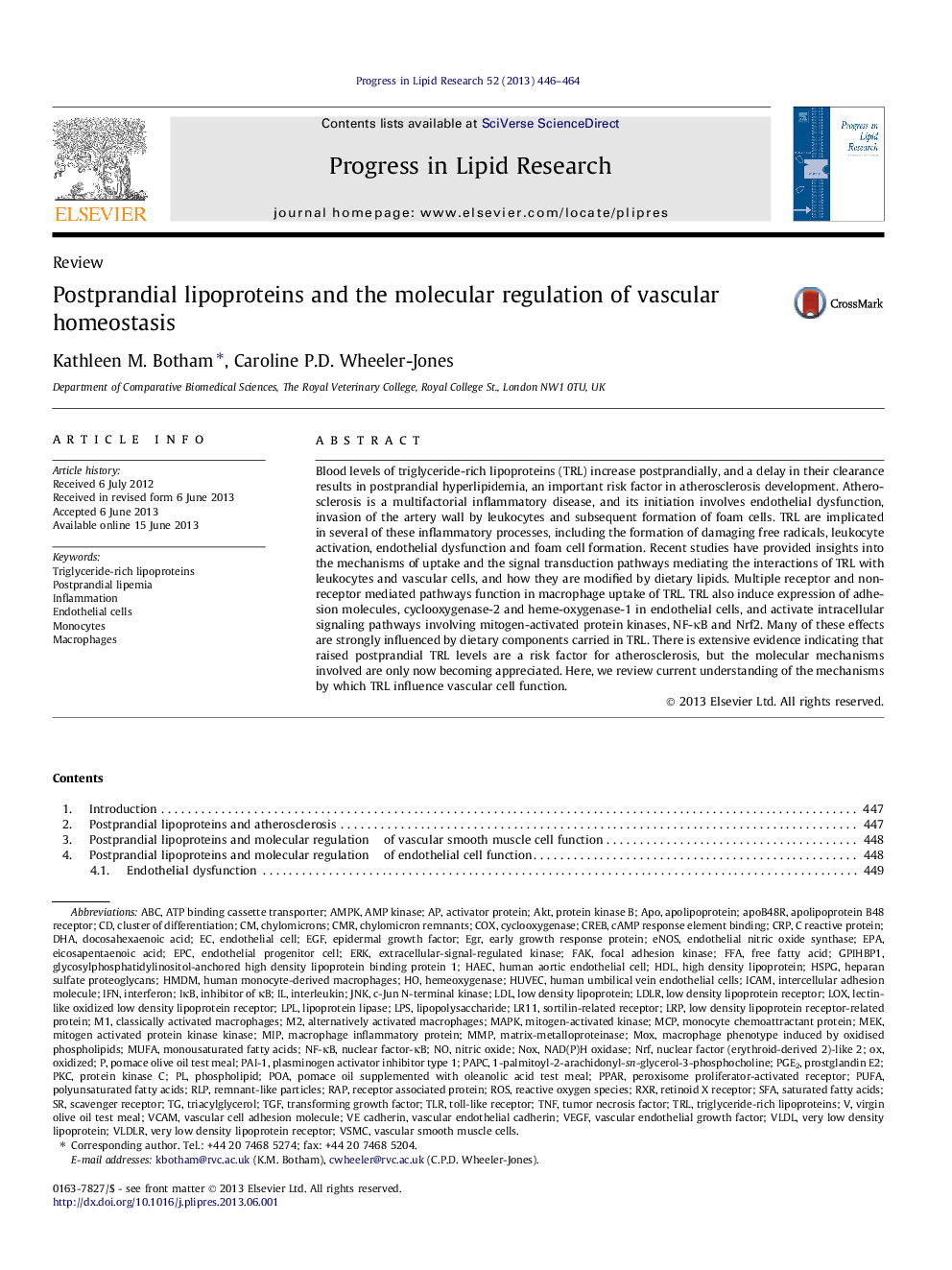| کد مقاله | کد نشریه | سال انتشار | مقاله انگلیسی | نسخه تمام متن |
|---|---|---|---|---|
| 10842902 | 1068556 | 2013 | 19 صفحه PDF | دانلود رایگان |
عنوان انگلیسی مقاله ISI
Postprandial lipoproteins and the molecular regulation of vascular homeostasis
ترجمه فارسی عنوان
لیپوپروتئین های پس از فروپاشی و تنظیم مولکولی هوموستاز عروقی
دانلود مقاله + سفارش ترجمه
دانلود مقاله ISI انگلیسی
رایگان برای ایرانیان
کلمات کلیدی
ABCAMPKCREBEPANF-κBMMPEGFLPSCOXJnkMCPRAPEPCEGRMIPPOACMRLRPHDLFFAFAKERKNRFHUVECPGE2LDLRMUFASFAPPAReNOSIκBTLRPKCTGFRetinoid X receptorVSMCPAI-1ICAMVCAMLPLHSPGVLDLRXRTRLGPIHBP1LR11HMDMAMP kinaseRLPTNFATP binding cassette transporter - ATP مجهز به نوار کاستc-Jun N-terminal kinase - C-Jun N-terminal kinaseMAPK - MAPKMitogen activated protein kinase kinase - Mitogen فعال پروتئین کیناز کینازNAD(P)H oxidase - NAD (P) H اکسیدازNOx - NOXPAPc - PAPCROS - ROSVLDLR - VLDLcyclooxygenase - آنزیم سیکلواکسیژنازapo - آپوapolipoprotein - آپولیپوپروتئینAkt - آکتEicosapentaenoic acid - اسید ایکوزاپنتانوئیکdocosahexaenoic acid - اسید داکوزاگزوائونیکFree fatty acid - اسید چرب آزادPolyunsaturated fatty acids - اسید چرب اشباع نشدهPUFA - اسید چرب چند غیراشباعsaturated fatty acids - اسیدهای چرب اشباع شدهinflammation - التهاب( توروم) cAMP response element binding - الگوریتم پاسخ cAMPOxidized - اکسید شدهLOX - اکسیژن مایعHAEC - اینinterferon - اینترفرونIFN - اینترفرون هاinterleukin - اینترلوکینchylomicron remnants - بقایای چیلومیکرونMOX - به زودیtransforming growth factor - تبدیل فاکتور رشدtriacylglycerol - تری آسیل گلیسرول Toll-like receptor - تیالآرcluster of differentiation - خوشه تمایزDHA - دوکوساهگزائنوئیک اسیدRemnant-like particles - ذرات باقی مانده مانندhuman aortic endothelial cell - سلول اندوتلیال آئورت انسانEndothelial cell - سلول های اندوتلیالHuman umbilical vein endothelial cells - سلول های اندوتلیالی ورید ناف انسانVascular smooth muscle cells - سلول های عضلانی صاف عروقیEndothelial progenitor cell - سلول پیش ساز اندوتلیالEndothelial cells - سلولهای اندوتلیالendothelial nitric oxide synthase - سنتاز اکسید نیتریک اندوتلیالepidermal growth factor - عامل رشد اپیدرمیVascular endothelial growth factor - فاکتور رشد اندوتلیال عروقیVascular Endothelial Growth Factor (VEGF) - فاکتور رشد اندوتلیال عروقی (VEGF)tumor necrosis factor - فاکتور نکروز تومورnuclear factor (erythroid-derived 2)-like 2 - فاکتور هسته ای (erythroid-derived 2) -like 2nuclear factor-κB - فاکتور هسته ای κBPhospholipid - فسفولیپیدPostprandial lipemia - لیپمی پس از سزارینLipoprotein lipase - لیپو پروتئین لیپازhigh density lipoprotein - لیپوپروتئین با چگالی بالاtriglyceride-rich lipoproteins - لیپوپروتئین های غنی از تری گلیسیریدvery low density lipoprotein - لیپوپروتئین چگالی بسیار کم استlow density lipoprotein - لیپوپروتئین چگالی کمLDL - لیپوپروتئین کم چگالی(کلسترول بد)lipopolysaccharide - لیپوپلی ساکاریدmatrix-metalloproteinase - ماتریکس متالوپروتئینازMacrophages - ماکروفاژها،درشت خوارهاhuman monocyte-derived macrophages - ماکروفاژهای حاصل از مونوسیت انسانAlternatively activated macrophages - ماکروفاژهای فعال متناوبClassically activated macrophages - ماکروفاژهای کلاسیک فعالMEK - مجاهدین خلقinhibitor of κB - مهار کننده κBintercellular adhesion molecule - مولکول چسبندگی بین سلولیvascular cell adhesion molecule - مولکول چسبندگی سلولی عروقیMonocytes - مونوسیتهاPlasminogen activator inhibitor type 1 - نوع مهار کننده فعال کننده پلاسمینوژن 1Nitric oxide - نیتریک اکسیدhemeoxygenase - همایکئوژنازmacrophage inflammatory protein - پروتئین التهابی ماکروفاژmonocyte chemoattractant protein - پروتئین شیمیایی monocyte chemoattractantactivator protein - پروتئین فعال کنندهreceptor associated protein - پروتئین مرتبط با گیرندهlow density lipoprotein receptor-related protein - پروتئین مرتبط با گیرنده پروتئین لیپوپروتئین کمC reactive protein - پروتئین واکنشی CCRP - پروتئین واکنشی سی یا سی. آر. پی early growth response protein - پروتئین پاسخ رشد اولیهprotein kinase B - پروتئین کیناز BProtein kinase C - پروتئین کیناز سیheparan sulfate proteoglycans - پروپوگلیکان های سولفات heparanchylomicrons - چیلومیکن هاvascular endothelial cadherin - کادرفین اندوتلیال عروقیextracellular-signal-regulated kinase - کیناز تنظیم شده خارج سلولی سیگنالmitogen-activated kinase - کیناز فعال با mitogenfocal adhesion kinase - کیناز چسبندگی کانونیReactive oxygen species - گونههای فعال اکسیژنperoxisome proliferator-activated receptor - گیرنده فعال فعال پروکسیومVery low density lipoprotein receptor - گیرنده لیپوپروتئین بسیار کم چربیlow density lipoprotein receptor - گیرنده لیپوپروتئین چگالی کمScavenger receptor - گیرنده مخربsortilin-related receptor - گیرنده وابسته به سورلیین
موضوعات مرتبط
علوم زیستی و بیوفناوری
علوم کشاورزی و بیولوژیک
دانش تغذیه
چکیده انگلیسی
Blood levels of triglyceride-rich lipoproteins (TRL) increase postprandially, and a delay in their clearance results in postprandial hyperlipidemia, an important risk factor in atherosclerosis development. Atherosclerosis is a multifactorial inflammatory disease, and its initiation involves endothelial dysfunction, invasion of the artery wall by leukocytes and subsequent formation of foam cells. TRL are implicated in several of these inflammatory processes, including the formation of damaging free radicals, leukocyte activation, endothelial dysfunction and foam cell formation. Recent studies have provided insights into the mechanisms of uptake and the signal transduction pathways mediating the interactions of TRL with leukocytes and vascular cells, and how they are modified by dietary lipids. Multiple receptor and non-receptor mediated pathways function in macrophage uptake of TRL. TRL also induce expression of adhesion molecules, cyclooxygenase-2 and heme-oxygenase-1 in endothelial cells, and activate intracellular signaling pathways involving mitogen-activated protein kinases, NF-κB and Nrf2. Many of these effects are strongly influenced by dietary components carried in TRL. There is extensive evidence indicating that raised postprandial TRL levels are a risk factor for atherosclerosis, but the molecular mechanisms involved are only now becoming appreciated. Here, we review current understanding of the mechanisms by which TRL influence vascular cell function.
ناشر
Database: Elsevier - ScienceDirect (ساینس دایرکت)
Journal: Progress in Lipid Research - Volume 52, Issue 4, October 2013, Pages 446-464
Journal: Progress in Lipid Research - Volume 52, Issue 4, October 2013, Pages 446-464
نویسندگان
Kathleen M. Botham, Caroline P.D. Wheeler-Jones,
